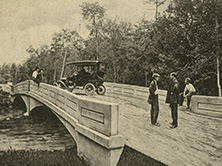 Concrete arched bridge on new, state-sponsored Charlotte to Wilmington Highway near Laurinburg—"one of 15 concrete bridges in Scotland County"—about 1911 (Durwood Barbour Collection of North Carolina Postcards, UNC-Chapel Hill)
Concrete arched bridge on new, state-sponsored Charlotte to Wilmington Highway near Laurinburg—"one of 15 concrete bridges in Scotland County"—about 1911 (Durwood Barbour Collection of North Carolina Postcards, UNC-Chapel Hill)
The North Carolina Historic Bridge Inventory project was a cooperative, interagency effort of the NCDOT, the North Carolina Division of the Federal Highway Administration, and the North Carolina State Historic Preservation Office. The North Carolina Historic Bridge Website project is a cooperative effort of the same three agencies, with the purpose of educating the public about North Carolina’s historic bridges.
The Historic Bridge Inventory was a survey of more than 5,000 bridges on the state's highway systems that were built, with a few exceptions, prior to 1961. Most of these bridges were owned by North Carolina, but some were in the hands of municipalities or federal agencies. The inventory's primary purpose was to identify which bridges were historic as defined by the National Register of Historic Places. While North Carolina has a few monumental historic bridges, most are best classified as ordinary highway bridges that are significant because they well-represent periods and styles of construction in the state’s bridge-building history. Most of these once-ordinary technologies had a limited shelf life, either evolving and adapting to new economic conditions, materials, or methods of construction, or disappearing from use altogether.
The information generated by the Historic Bridge Inventory is useful in environmental studies, transportation planning, and preliminary engineering, as well as promoting an appreciation and understanding of the state's engineering and transportation history. Historic bridges are generally subject to the provisions of the US Department of Transportation Act and the National Historic Preservation Act, which address the way state highway agencies handle historic properties impacted by federally funded or permitted projects.
The inventory consisted of several work products, including an electronic database with attached photographs and maps, in-depth historic contexts that place the bridges in the perspective of the history of transportation and engineering in North Carolina, and survey forms and 35-mm photography. Readers wishing detailed information, especially about individual bridges, may consult these materials at the NCDOT’s Project Development and Environmental Analysis Branch. Or, more easily, they can find information on this website on the 204 bridges that were determined to be historic following completion of the inventory.
Most of the text included in the North Carolina Historic Bridge website is adapted from the North Carolina Department of Transportation Historic Bridge Inventory Report of January 2005, written by historian Patrick Harshbarger of Lichtenstein Consulting Engineers, which inventoried the state’s historic highway bridges in the early 2000s.